mytest
Books etc. by ARUDOU Debito (click on icon):
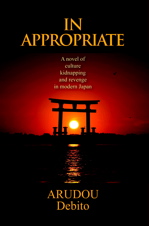




![]()

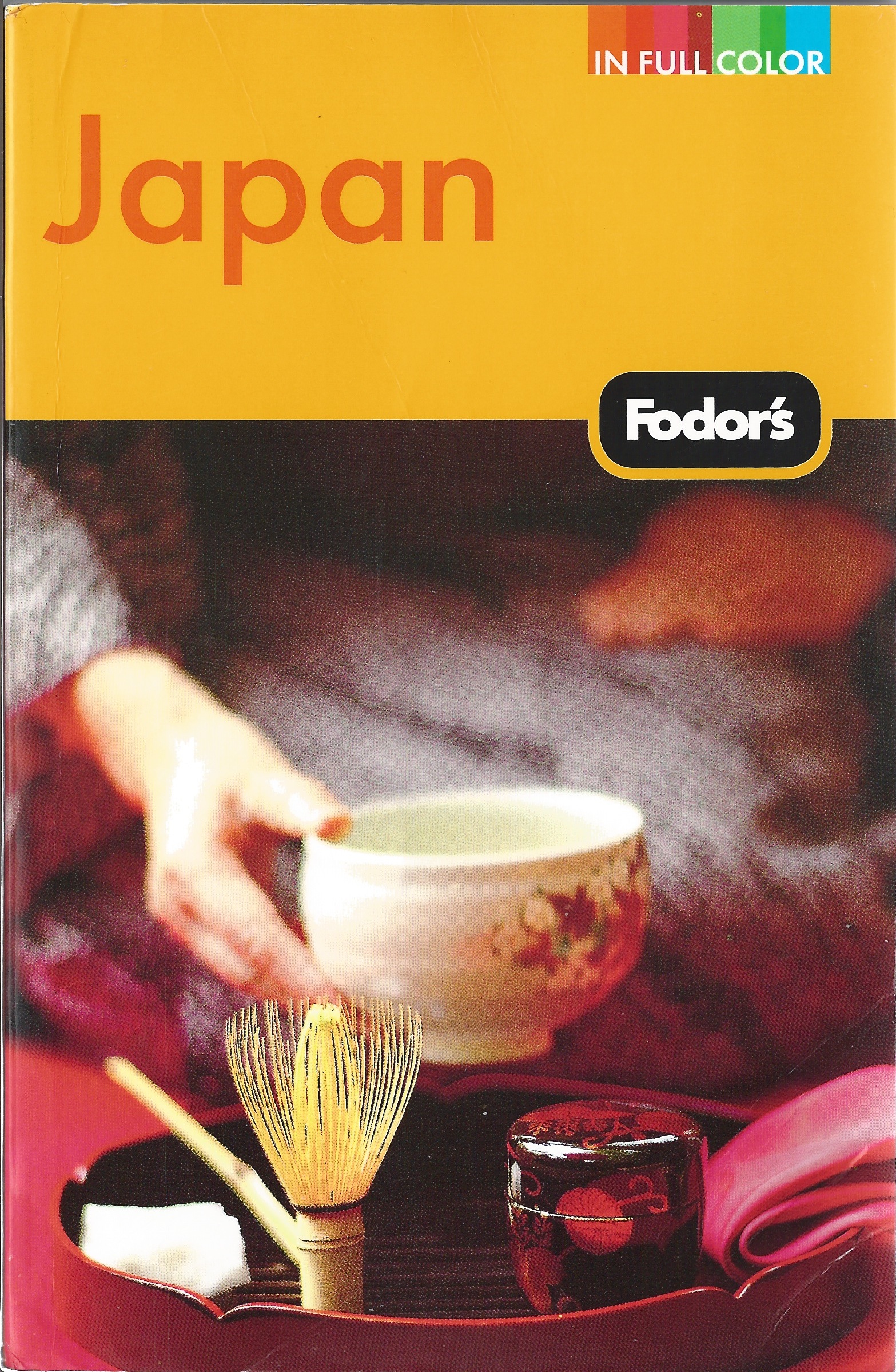
UPDATES ON TWITTER: arudoudebito
DEBITO.ORG PODCASTS on iTunes, subscribe free
Hi Blog. Been doing some writing and inserting into my research the definition of “gaijin” in Japan in terms of marketing. You might remember this little tidbit from Debito.org, March 25, 2009:
Well, when I was looking up the maker and sales price on Amazon Japan last night, guess what I discovered. The product has now been changed, as of August 2012:
Note the stereotypical racialized characteristics for both “dokkiri” party goods include large a large nose, blue eyes, cleft chin, blond hair, “Hollywood smile,” and grand gesticulations. The default language for the “foreigner” (as seen by the harō and ha-i!) is English (if not katakana Japanese for the desu copula). However, “gaijin” has been adjusted to “gaikokujin” (as if that makes the commodification of racism all better).
Note also that even though this apparently has been a recent change (information was received by Amazon Japan only last month), it’s suddenly “currently unavailable” and “can not be shipped outside Japan“. (I wonder if anyone looking at the product with an IP in Japan is also unable to purchase it.) See screen capture here:
(Screen capture as of September 22, 2012.)
Same thing with the racialized Little Black Sambo dolls I found on Amazon Japan last night (which have been on sale since shortly after unbook Little Black Sambo was resuscitated in Japan, extending racism into the next generation): It’s also “currently unavailable.” And anyway not for sale outside of Japan. So methinks the producers are well aware that they could get in trouble if marketed to an overseas audience. But no matter — there’s money to be made here — who cares if the product is racialized when the domestic market from childhood thinks racism of this sort is unproblematic? (Moreover believes it only goes one way — given the Perpetual Victim Complex, Japanese are more likely to be the victims of racism than the perpetrators of racism, of course.)
Anyway, I think Debito.org can claim credit for the “gaijin” => “gaikokujin” change. Who else is covering this issue and archiving it? I have the feeling that they saw it (as news anchor Kume Hiroshi did back in 2006, when he apologized ten years later for an obnoxious remark he made on national TV about “gaijin” back in 1996) and felt embarrassed enough to make some adjustments. Not embarrassed enough to take it off the market, of course (as Mandom did their racist product back in 2005). But we’re working on that.
Thanks for your support, everyone. Arudou Debito
UPDATE Sept 24: Here are a couple more, courtesy of the same company (thanks Debito.org Readers): The “Kurohige Gaijin-san” (beard seems to be chiseled to look a bit like Tony “Darling Foreigner” Laszlo‘s comic character) and the “Hana Megane Gaijin-san.”
http://www.kk-jig.com/products/orderno_6156/
http://www.kk-jig.com/products/orderno_6084/1/
However, the packaging for the Gaijin Beard mask is significantly different if you find it on the store shelves. The image is less Tony Laszlo, more mullah. Courtesy of DMG, taken at Tokyu Hands Shibuya, September 23, 2012.
Funny how the mullah glasses even have UV protection…

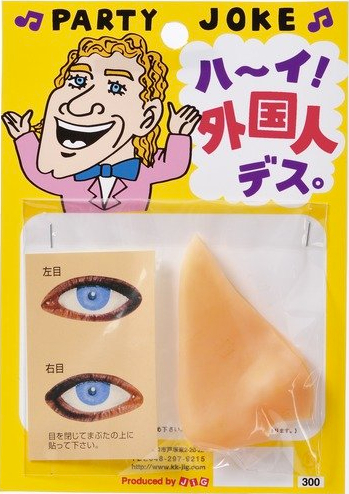
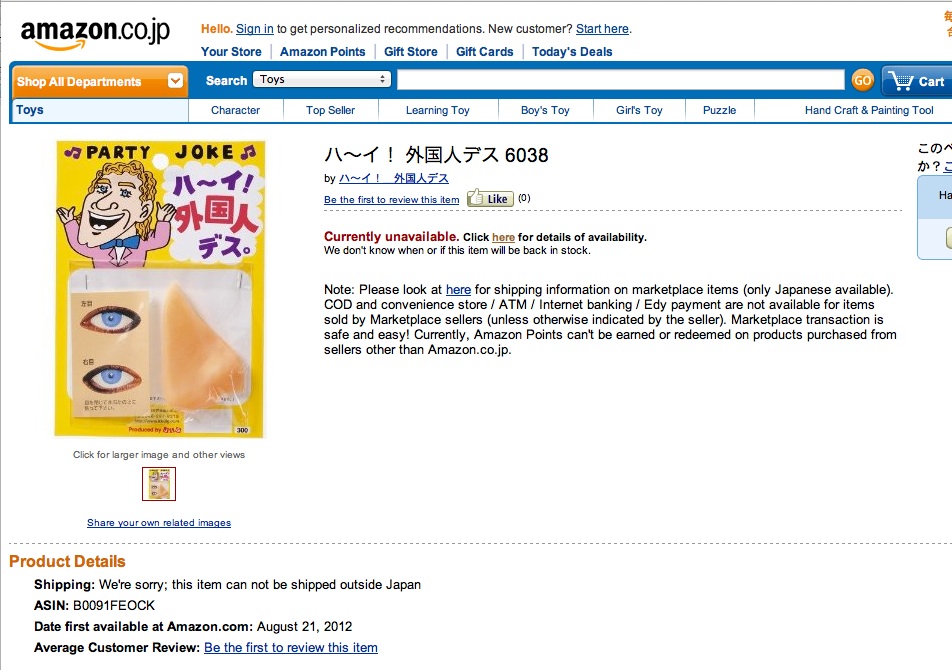

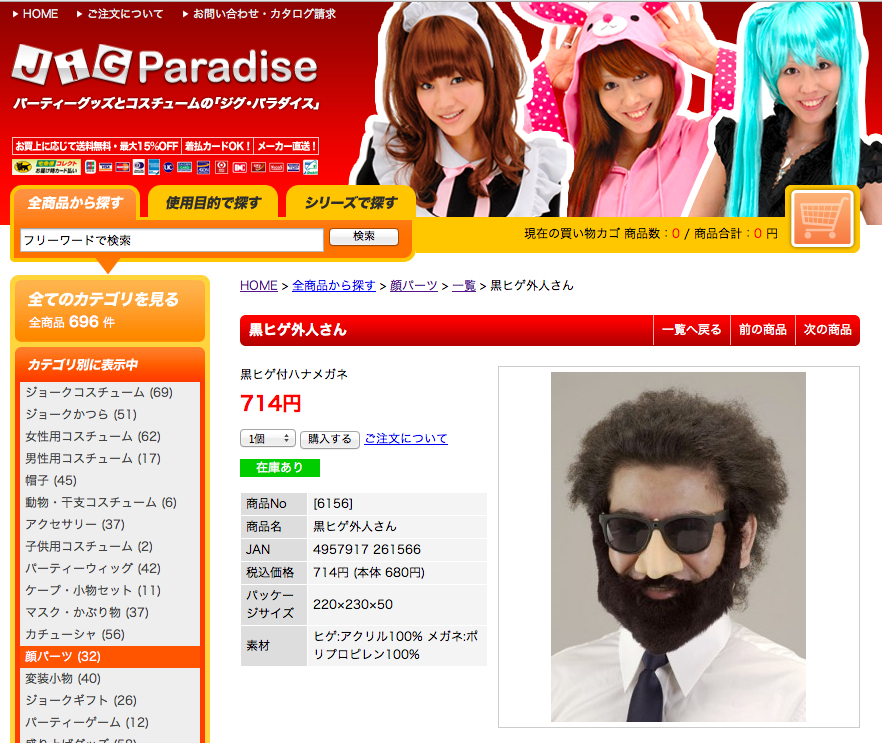
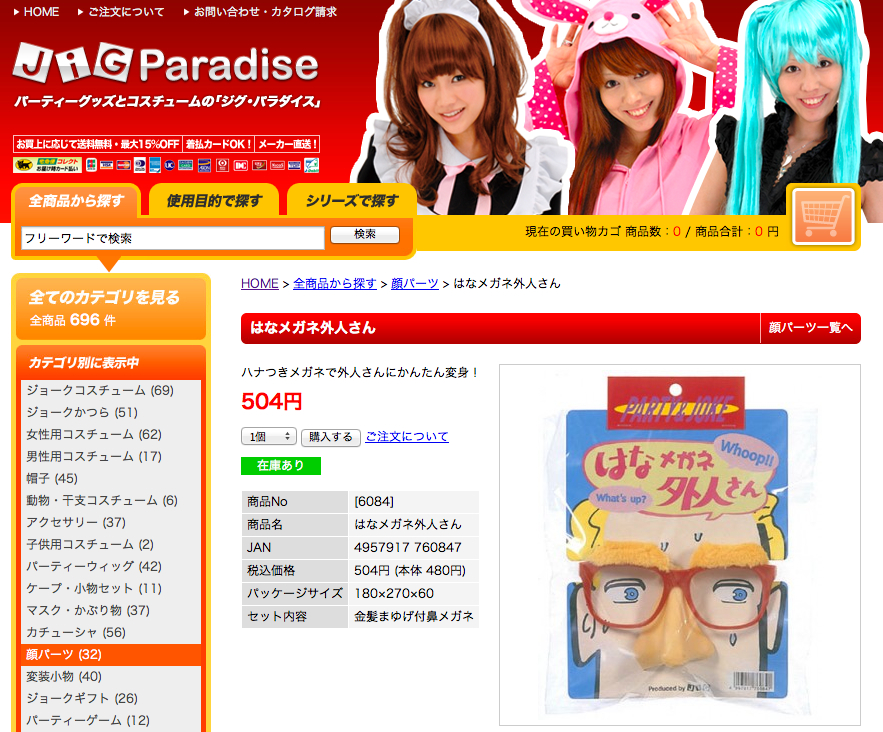
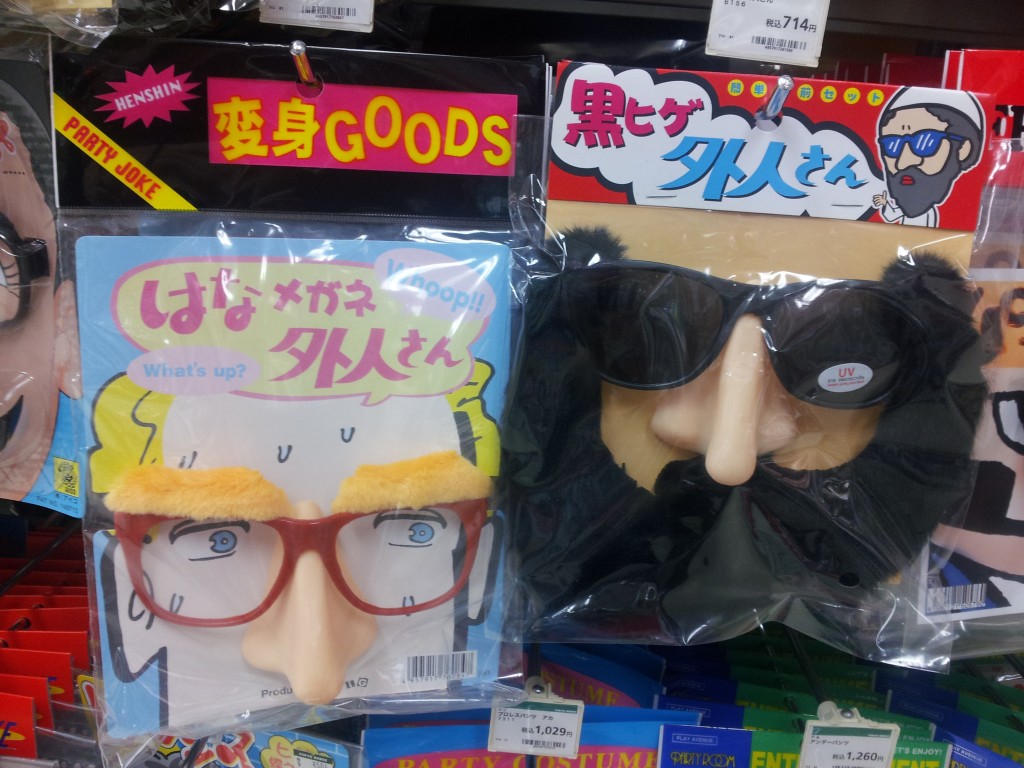
22 comments on “Success, of a sort, as a “Gaijin Mask” maker amends their racist product to “Gaikokujin Masks”. Same racialized marketing, though.”
No, the “Shipping: We’re sorry; this item can not be shipped outside Japan” has nothing to do with overseas reactions (“So methinks the producers are well aware that they could get in trouble if marketed to an overseas audience”). I copied this “Shipping: We’re sorry; this item can not be shipped outside Japan” from a random result for a search for “Lego”.
Same thing with toys at the US Amazon. They don’t ship overseas either.
Just checked. I can order it, but nor for shipment outside of Japan.
HTH.
— Thanks Bill and Kimpatsu.
“who cares if the product is racialized when the domestic market from childhood thinks racism of this sort is unproblematic?”
You said a mouthful there, bruh!
And with all this foolishness over that island, racialized speech (and probably products) aimed at Chinese has been and will continue to be oin the rise (as if it weren’t high enough) I’ve had three conversations of late with private Japanese students that was just short of the kind of epithets that polluted the airways and media about Chinese back in America’s Golden Age. Like it’s been sanctioned. Anyway, keep up the labor of love, yo. The streets is watching, believe that!
Concerning the history of the Little Black Sambo/Chibikuro Sanbo series in Japan, Debito & readers might be interested in having a look at this amazingly revealing and self-serving paper, now available on line, by Prof. Kazuo Mori:
“A COMPARISON OF AMUSINGNESS FOR JAPANESE CHILDREN AND SENIOR CITIZENS OF THE STORY OF LITTLE BLACK SAMBO IN THE TRADITIONAL VERSION AND A NONRACIST VERSION” Social Behavior and Personality, 2005, 33(5), 455-66.
http://www.tuat.ac.jp/~sarmac/MoriSBP2005.pdf
ABSTRACT: Japanese versions of The Story of Little Black Sambo (LBS) were perceived to have racist characterizations and were withdrawn from the Japanese market in 1988. A revised version of LBS was prepared that contained no words or pictures related to racism and was compared with a version of LBS published by Iwanami Publishing Co. in terms of amusingness. Fifty- four kindergarteners, four to five years old, and 43 senior citizens, 78.9 years old on average, were read a picture book popular in Japan, followed by either the revised or the Iwanami version of LBS and then asked to judge which of the two stories was more amusing. The results showed equal levels of amusingness between the Iwanami and the revised versions of LBS in both age groups.
This speaks volumes of the lengths to which the Japanese can go to defend the indefensible.
As if what is at stake in LBS is simply a question of “amusingness”!
The whole argument defies belief.
— Yes. Mori misses the point. It’s not whether the traditional and the sanitized versions are equivalent in “amusingness” (however quantified: he manages to — without a clear definition of what is meant by “amusing” — and even runs a regression on a total sample size of 54 children and 43 senior citizens — how definitive!).
It’s whether LBS would be as well received if one put the shoe on the other foot — what if a race/ethnicity/phenotype that the reader self-identified with was portrayed similarly? Would that be so “amusing”? I gave it a go with my “Little Yellow Jap” parody. And boy was that decried. I’d love to see Mori do a survey on that (a rigorous one with defined terms and a larger sample size, that is).
Sometimes I wonder whether overseas publications lower their scientific standards for submissions from Japan, because the former realizes that, given the lousy methods that pass for bona fide social-science endeavor in Japan, they’ll just have to take what they can get. But when you get “overseas publication” laundering of credentials like this, you get idiotic quotes from these people as “experts” in the media setting the tone of domestic discourse (like the following one demonstrating that Mr. Mori, as a citable authority on LBS, doesn’t understand the process of racism at all):
From “Sambo returns to bookracks in Japan,” Chicago Tribune June 13, 2005:
So here we have a certified social scientist stating for the record in his professional opinion (as a representative of all Japan, no less; viz. “us”) that racism without racist intent cannot be racism. That would not pass muster in any Western academic journal dealing with racism. Now THAT’s “amusing”.
Well done Debito. Another step forward. Let’s wait and see how the apologists try to spin this one! You’re definitely on a roll lately, great to see!
Certainly these products are designed to laugh at foreigners and make them into a joke as a way of dehumanizing them. That this even exists shows we have a long way to go and exposes those who try to justify anything in the name of respecting Japanese culture. Well, you can’t justify this!
I tend to think that this type of product is actually less problemat than the underlying strong xenophobia pervading society.
I mean that my experience has been that in social groups in which there does exist acceptance of others, that such stereotypical items can be used to laugh with one another rather than laugh at one another.
As such, the context is critical.
In Japan, the context is of rather clear marginalisation and xenophobia.
Are there more such items perhaps on the manufacturer’s website:
http://www.kk-jig.com/ ?
— Yes. Try the “Kurohige Gaijin-san.” (Even if it’s not specifically “blond therefore clearly foreign”, that’s not how it’s being marketed (beard seems to be chiseled to look a bit like Tony “Darling Foreigner” Laszlo‘s comic character).
(Click on image to expand in browser. Or go to:
http://www.kk-jig.com/products/orderno_6156/)
Then there’s the “Hana Megane Gaijin-san.”
(Click on image to expand in browser. Or go to:
http://www.kk-jig.com/products/orderno_6084/1/)
All we need now I guess is some way to change skin colors too and we’ll have more “races” within our racialized commodities. Oh wait, I just heard from a friend that a local toy store he knows has a “Black Man Set” — replete with Afro-wig and chocolatey brown face paint. He’s working on getting us a photo.
I see the item listed here at:
http://www.kk-jig.com/products/orderno_6038/
Well, lets order some, and send them to the IOC! See if they appreciate racist humor.
A paper submitted on the very same mask
Sakata, Fumi, “A Critique of Critical Race Theory: A Textual Analysis of the ‘Mr. Gaijin’ Mask.” MA Thesis, Queens University, Canada, August, 2012.
http://130.15.126.37/jspui/bitstream/1974/7387/1/Sakata_Fumi_201208_MA.pdf
— Yes, quite. Looks like other people have been paying attention, good. Debito.org is not credited as a source within her research (Japan Probe is, good for them, but JP cited Debito.org a year and a half after it first appeared here; guess they’re somehow more credible a source). It’s interesting how the other “Gaijin-san” items mentioned here have not been similarly amended. Perhaps because they haven’t received the same attention (they also aren’t mentioned in Sakata’s thesis). Ah well.
Is there a potential market for black-framed glasses with fake slitty eyes on the lenses, and huge buck teeth? Surely we can sell them as “Mr. Jap” masks.
Don’t worry about people being overly sensitive – “Jap” is not an offensive word (it doesn’t apply to me, so it can’t be offensive), and anyway I’ve included the title “Mr.”, which makes everything alright.
*[sarcasm here being the flip-side of comments appearing in letters to the editor in various English language newspapers by natives of this country]
I don’t see adding a 国 in there makes it any less racist. 外国人 is not a single category of people, yet it’s used as if it is descriptive. So not only is the mask making fun of a group of people who have certain physical characteristics and applying them to a group that doesn’t necessarily (and overwhelmingly doesn’t) have those characteristics. I wouldn’t all that ‘progress’ at all. I’d call it an illustration of the profound misunderstanding of what bigotry is. Or perhaps it’s an illustration that this country lacks the fundamental human value of empathy.
The ability to be this willfully ignorant is kind of impressive.
Here’s how my girlfriend explained it to me:
Korean = Koreans
Chinese = Chinese
Black = Black People
外国人 = White People
mfw = O_o
Debito here again. I pasted a screen capture of the “Kurohige Gaijin-san” mask above. However, its packaging is significantly different if you find it on the store shelves. The image is less Tony Laszlo, more mullah. Courtesy of DMG, taken at Tokyu Hands Shibuya, September 23, 2012.
Funny how the mullah glasses even have UV protection…
Debito,
Many thanks for your comment above (#4 ).
In the meantime, I have found another article by K. Mori, published in the same year (2005) in a non-academic magazine, in which the logic behind his argument gets even more muddled, and he ends up by admitting that “neither the book’s racist tone nor its shady publishing history are enough to stand in the way of a good read or a handsome profit. Confronting the shameful history of Chibikuro Sambo in Japan is necessary if we are to show the world that we take racism seriously.”
Yet, it’s interesting – and even amusing – to notice how he never questions the methodology nor the results of his “psychological experiments”, which he succinctly describes as follows:
“In my work as a research psychologist, I have been trying to prove that the popularity of Chibikuro Sambo is not due to racial discrimination among the Japanese people. My hypothesis was that they love it simply because they are fond of its story. The hero happens to be a black boy, but the Japanese would enjoy the book just as much if he were a white girl or anything else. [what about if the hero were a stereotypical Japanese, as in Debito’s parodic version?]
That’s the reason I made a race-free version of the book, which I called Chibikuro Sampo (“sampo” means “taking a walk” in Japanese). I changed the protagonist to a black Labrador [but why does the protagonist remain black in the “non-racist” version?] who goes for a stroll in the jungle and encounters four tigers. Then I let Japanese children compare this book with the original. If they found both versions equally enjoyable [doesn’t he mean “amusing”?], it would indicate that they love the book because of its fantastic story. My psychological experiments did, in fact, show this exact result.”
Kazuo Mori, “BACK IN BLACK: WHAT HAVE WE LEARNED FROM CHIBIKURO SAMBO?”
http://www.tuat.ac.jp/~sarmac/610LastWord.pdf
Well, so much for “social science” at Japanese universities…
i wonder if i tried to wear glasses and buck teeth would that be racists too? How ironic would that be if I dressed like a japanese for halloween?
I wasn’t sure whether to laugh or cry ; if you go to Japanzine on Facebook(https://www.facebook.com/japanzine) they wonder whether the 「ハロ 外人」will – oh here it is: ” ¥100,000 for best costume at The Sexy Halloween Party. Will your “Big Gaijin Nose” costume win?”
Info here: http://www.facebook.com/events/414214138643099/
日本最大級のハロウィン仮装コンテストは賞金付き!
なんと現金10万円が当たるよ!是非仮装して来てね!
http://www.facebook.com/events/414214138643099/
Some people at Japanzine may be readers of Debito’s blog?
On one level I’d be tickled by the idea of hundreds of “gaijin” walking around “whitefaced.” But somehow I find it a bit problematic. Will Japanese people taking part get the joke? Does it matter in this case?
Unfortunately, it may result in (marginally) more sales of this product, which at best is silly, but ultimately does reflect a culture of racism and discrimination/ othering that is so deeply embedded here.
And, as we know, there are thought / behavior police in Japan who seem to hate the idea of “gaijin” enjoying themselves at Halloween anyway.
— Sure are. Here are some archives about Japan’s Hallowe’en Police.
http://www.debito.org/?p=4905
http://www.japanprobe.com/2009/11/01/anti-foreign-protests-in-tokyo-on-halloween-night/
(with anti-Hallowe’en signs)
And in a step backwards, restaurant chain Gusto now has a TV commercial featuring comedy duo Angaaruzu wearing blond wigs and fake noses while trying to win the affections of some blond Italian chick.
http://www.youtube.com/watch?feature=player_embedded&v=i97835BOq6o
And direct from the chain’s website
http://www.skylark.co.jp/gusto/italian2013/index.html
I don’t know what’s worse… the fact that they make stuff like this, or the fact that they don’t seem to realise it’s offensive. I would say they’ve lost my custom, but the food they sell is so revolting I stopped going years ago. Bad all round.
And check out what Terry Ito had to say for his pledge for Tokyo’s 2020 Olympic bid:
http://www.ko-yaku2020.jp/
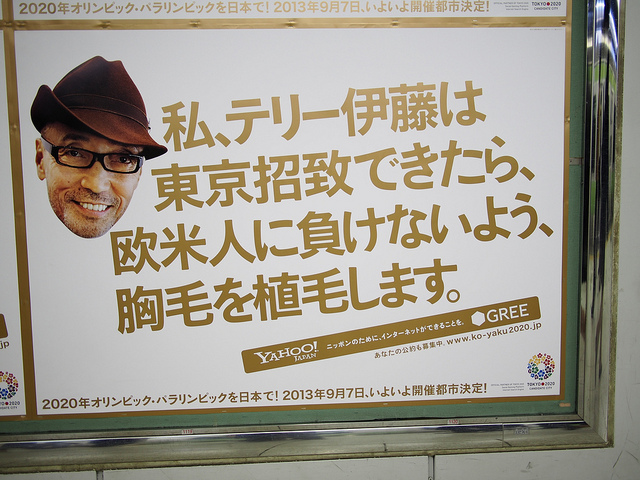
http://www.flickr.com/photos/hshttsr/8329567121/sizes/c/in/photostream/
Not to mention ads which feature NJs voices being dubbed over in Japanese with ridiculous accents.
http://youtu.be/HARn7qRCBVo
http://youtu.be/iYBAH1yHs68
The foreigner party joke masks have been updated again: http://gakuran.com/hi-im-a-foreigner-racist-party-mask/
— Thanks for using Debito.org to promote your own website without giving sufficient credit to the sources of your information.